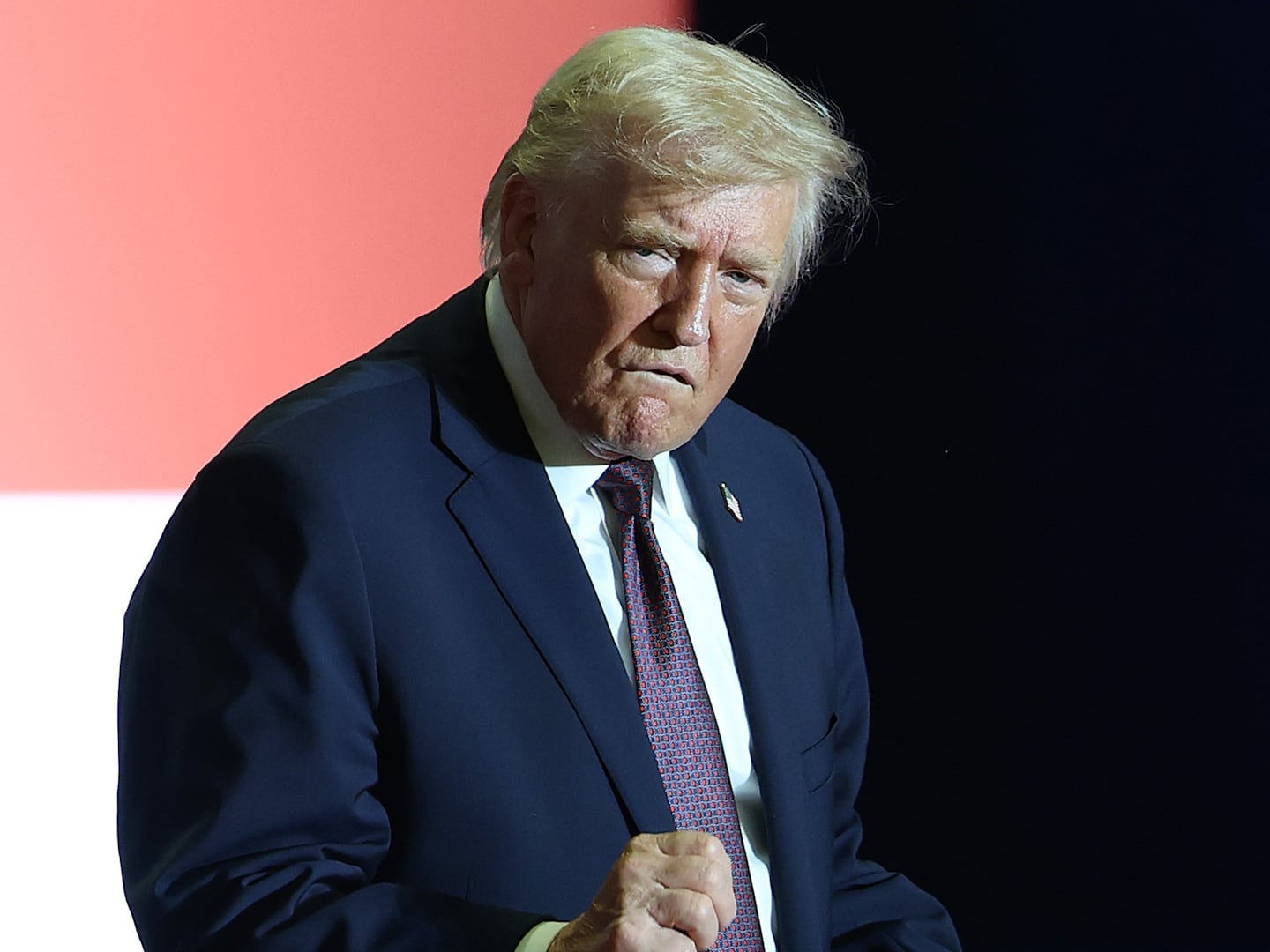Two days before the Capitol riot, Doug Mastriano ended one of his frequent Facebook Live videos on an abrupt note. The Pennsylvania state senator had referenced his upcoming speech at a pro-Trump Stop the Steal conspiracist rally in D.C. on Jan. 6 but didn’t want to discuss the event on his official government page.
“We’re gonna hop over on the other page, Doug Mastriano Fighting For Freedom, where we can talk freely,” Mastriano told viewers, directing them to his personal Facebook account. “So please follow me over to Doug Mastriano Fighting For Freedom, we’ll continue the conversation off of this government page, and onto a page where we can speak freely about everything.”
The video on his personal account has since been deleted, along with other posts related to Mastriano’s activity on Jan. 6. But his social-media strategy, beginning with open courtship of the QAnon conspiracy theory, has long walked the line between elected official and far-right instigator. Via a network of near-identical Facebook pages, Mastriano has amassed a following that calls itself his “army.” And while some Mastriano fans are facing prison time for their alleged involvement in the Capitol riot, the state senator has continued to push election-fraud hoaxes, culminating this month in his demand for an “audit” of the 2020 presidential election in Pennsylvania.
Mastriano spent much of his career in the military, deploying three times to Afghanistan and reaching the rank of Army colonel before his retirement in 2017. Soon after that, he entered into a different form of battle: the world of the QAnon conspiracy theory and its self-described “digital soldiers.”

In February 2018, Mastriano announced his bid to represent Pennsylvania in the U.S. House of Representatives. Like many first-time candidates establishing an internet presence, Mastriano registered his Twitter account the same month as his announcement. Some of his first tweets were equally conventional: links to his campaign website, descriptions of his work in the military, photos of family.
But months into his campaign, Mastriano began soliciting attention from more fringe figures. In May of that year, he tweeted at far-right internet personality Jack Posobeic, asking for an endorsement. That month, he also tweeted that the artist of a school mural should face 20 years in prison for that painting, which depicted an Aztec warrior beheading Donald Trump.
By that August, Mastriano’s tweets regularly included eyebrow-raising hashtags.
“#QAnon #MAGA #Trump2020 #PatriotsFight #TheGreatAwakening #Trump,” Mastriano wrote in multiple early tweets. The identical order of the hashtags across the tweets suggests that Mastriano repeatedly copy-pasted the string of hashtags. A Media Matters report this month found that Mastriano tweeted the “#QAnon” hashtag more than 50 times. Included in Mastriano’s hashtagged tweets were pictures of Donald Trump as an anime character, and a cartoon girl in a sailor uniform staring wistfully at a Trump sign.
The QAnon conspiracy theory falsely accuses Trump’s enemies of a number of outrageous acts, including pedophilia and/or child cannibalism.
Mastriano lost his congressional bid but won a special election for a state Senate seat the following year. Billing him as a candidate for “protecting families,” Mastriano’s campaign site advertised his belief that “marriage is between a man and woman—and that no amount of disinformation or political correctness will change these facts.” (He also caught flak that year for multiple anti-Muslim posts, including one that claimed “Islam wants to kill gay rights, Judaism, Christianity, and pacifism,” and another that falsely accused Rep. Ilhan Omar of encouraging the attempted murder of a child in a mall.)
As the COVID-19 pandemic swept the country in spring 2020, Mastriano expanded his online audience with a recurring series of “fireside chats” on Facebook Live, during which he slammed health precautions. After one such video, in which Mastriano appeared to encourage listeners to quit churches that did not hold in-person services, a coalition of nearly 50 religious leaders in his district signed a letter complaining about his remarks.
By November 2020, when Mastriano joined legions of far-right conspiracists in falsely claiming that fraud had cost Trump a second term, the Pennsylvania lawmaker’s fans were beginning to take up a new name for themselves: “Mastriano’s Army.”
Some of the hashtag’s earliest invocations came in attacks on Mastriano’s foes. Supporters tweeted it alongside photoshopped images of President Joe Biden in jail, as well as at a Democratic Pennsylvania lawmaker who spoke out against Mastriano.
Not all of those fans were even Mastriano’s constituents; one such attack on Biden, for instance, came from a Pennsylvanian who lists their location as outside Mastriano’s district. But Mastriano encouraged that support across the state.
Beginning in September, Mastriano became an administrator for nearly 40 county-level Facebook pages dedicated to him. The pages, discovered by Erin Gallagher, a researcher of disinformation at Harvard University’s Shorenstein Center, include groups like “Philadelphia County For Doug Mastriano,” despite Mastriano not representing that area of the state.
Gallagher also found Mastriano to be an administrator in the Facebook groups “Senator Doug Mastriano, We the people ask you to run for governor!” and “Draft Senator Douglas Mastriano for Governor of Pennsylvania.” The first group currently has more than 16,000 members.
Mastriano’s activity was not limited to the online sphere.
The #MastrianosArmy hashtag is full of pictures of Mastriano with fans at pro-Trump, post-election events, including one in which he poses with a woman in a shirt with a QAnon slogan. By last December, as the myth that the election was stolen germinated, those pictures were increasingly geotagged in Washington, D.C., where Mastriano fans marched at pro-Trump events while holding signs with Mastriano slogans like “walk as free people.” In a harbinger of the election obstruction to come, at least one group photo of “Mastriano’s Army” at a D.C. rally in December was hashtagged “#DoNotCertify.”
Mastriano was a scheduled speaker at the Jan. 6 rally that preceded the Capitol attack. In a video blitz two days before the rally, he promoted it in the now-deleted Facebook Live video, as well as in an appearance on a far-right radio show during which he described Republicans as “in this deathmatch with the Democrat Party.” He was also responsible for transporting some of the event’s attendees into the city—six days before the riot, Mastriano used $3,354 in campaign funds to reserve buses to D.C., according to campaign finance documents reviewed by Philadelphia’s WHYY.

Mastriano speaks at a protest against an extended stay-at-home order to help slow the spread of the coronavirus in Harrisburg, Pennsylvania, on April 20, 2020.
REUTERS/Rachel WisniewskiSandra Weyer, a Pennsylvania woman, was charged last month for allegedly breaking into the Capitol and encouraging a mace attack on a New York Times journalist. “Truth be known about storming the capitol . . . we were sick and tired of DITHERING!!!” Weyer tweeted about the event.
“Dithering” is a Mastriano catchphrase, as his colleagues noted positively before the riot. As photos hashtagged “#MastrianosArmy” in a pro-Mastriano Facebook group reveal, some of his fans have even made “We Don’t Dither” T-shirts. A New Yorker report previously suggested that Weyer rode on one of Mastriano’s buses, although Mastriano denies that. Weyer was previously pictured at a D.C. rally in December, where she held a Mastriano sign alongside a group of his fans.
Mastriano disavowed Weyer in an email to The Daily Beast, and generally rejected the idea that the crowd that has followed his social-media organizing trail was his responsibility. “Regarding your photo, it is a dangerous and nonsensical precedent to imply that a public figure is responsible for all of the actions of their supporters,” he wrote. (Mastriano did not respond to other questions for this story.)
Another alleged Capitol rioter, Samuel Lazar, has repeatedly been photographed alongside Mastriano, including at a Mastriano event in May, as HuffPost reported. Mastriano told the outlet he did not know Lazar, and that he condemned the man’s actions. Lazar, who appeared on video boasting about macing Capitol police, has not been charged with a crime, though his photo has appeared on FBI “wanted” lists.
Other alleged Capitol stormers overlapped with Mastriano’s circles. During the rally, the state senator posed for a photo with former Pennsylvania lawmaker Rick Saccone, who later posted on Facebook, “We are storming the capitol. Our vanguard has broken through the barricades. We will save this nation. Are u with me?” Saccone has not been charged with a crime. Rachel Powell, a Pennsylvania woman who is facing charges for allegedly smashing a Capitol window, traveled alone to the Capitol. Earlier that summer, however, she attended the same far-right July 4 event as Mastriano, when both showed up to Gettysburg National Military Park in response to a hoax about leftists burning flags there.
Mastriano, for his part, claims to have left the Capitol area before Jan. 6 turned to violence, even as footage from that day appears to show him in a crowd as the front of that group began to breach Capitol barriers. In a statement to HuffPost, Mastriano claimed to have respected police lines.
Despite calls for Mastriano’s resignation, or an investigation into his involvement with the Capitol riot, Pennsylvania’s Senate has not taken action against the lawmaker. Instead, Brian Sims, a state representative who has called for an investigation into Mastriano, has faced threats from members of Mastriano’s “army.” In one of Mastriano’s Facebook Live videos, a commenter noted that “Brian Sims has been rubbing me the wrong way for a few yrs. Maybe I’ll pay him a visit.”
Sims, in turn, accused Mastriano of attempting to get him killed.
Since the riot, Mastriano has joined the bandwagon of Trump supporters calling for “audits” of the 2020 election. The only such actual “audit” is a chaotic, ongoing affair in Arizona, staffed by conspiracy theorists and uncredentialed vote-counters. They have racked up millions in public funds while searching for “bamboo fibers” in ballots, based on a conspiracy theory about fake ballots being shipped from Asia.
In June, Mastriano took a trip to the site of the Arizona audit, which is being run by a Florida-based company whose CEO previously promoted election-fraud hoaxes. While the Arizona audit was ongoing, that CEO also participated in a documentary alleging voter fraud.
Nevertheless, in a blog post, Mastriano wrote that he “was more than impressed with what I saw on the ground in Phoenix.” He has not disclosed the funding of his trip, which he described in a Facebook Live video as a “justifiable business expense” that did not involve taxpayer dollars.
Mastriano, who has previously promoted a Telegram channel for a fringe group demanding a Pennsylvania audit, set out his own demand for an Arizona-style recount on July 7, and the Washington Post reported last month that he met with Donald Trump about the idea.
In an interview, Pennsylvania’s Lieutenant Governor John Fetterman dismissed the demand as a publicity stunt for what he suspects are Mastriano’s gubernatorial ambitions.
“It’s burnishing his own political credentialing to run for governor,” Fetterman told The Daily Beast. “That’s all this is. No one thinks it [the audit] is going anywhere. This is all just bad performance art.”
Mastriano asked three counties to turn over their voting machines. Two of the counties, (Tioga and York), have already declined, with their Republican commissioners stating that they could not compromise voting equipment by turning them over to a third party. Mastriano has threatened to subpoena the counties, an avenue that Fetterman recently characterized as unlikely to succeed, though some Republicans in the legislature have signaled potential support.
“This is just theatrics in an attempt to secure a Trump endorsement, which is obviously highly coveted in any Republican primary,” Fetterman said. “If you want to talk about what’s really insidious in Pennsylvania, it’s the blatant attempts to impose mandatory voter ID through a ballot initiative, which is straight-up voter suppression.”
Fetterman suggested Mastriano was tailoring his statements to a Trumpist audience. It was a recalibration previously evident in Mastriano’s changing tone on Twitter.
During those early days, when Mastriano was still searching for his audience, he tweeted a meme that falsely attributed a quote to Hillary Clinton. “Anybody not willing to accept the results of an election is a danger to democracy,” the quote read.
“Well well well,” Mastriano tweeted. “I actually agree with Hillary.”








